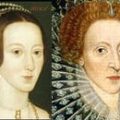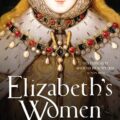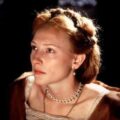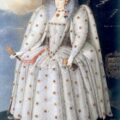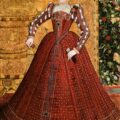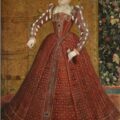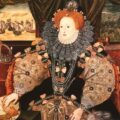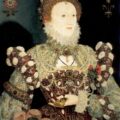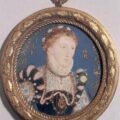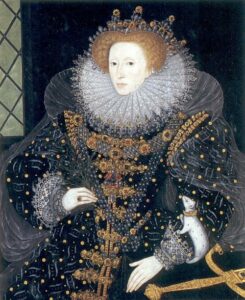
Why do I say this? Because, like many monarchs of her time, Elizabeth was more concerned with propaganda and with portraits depicting her as she wanted to be seen by her subjects and foreign powers, rather than how she herself actually looked. Alison Weir writes of how after Nicholas Hilliard painted a 40+ year old Elizabeth as an “icon of royalty”, Elizabeth “began to take an increasing interest in how she was represented, insisting upon the trappings and appearance of majesty taking precedence over any attempt at realism”.
We must also take into account Elizabeth’s vanity and her desire to be the most beautiful woman around, even later in her life when she suffered with bad teeth! Her later portraits certainly do not show bad teeth and wrinkles!
You can see a selection of portraits of Elizabeth on our gallery page – see what you think.
So, what do we actually know about Elizabeth’s appearance from written records? Let’s look at what historians and historical sources say of Elizabeth in her youth:-
Elizabeth I’s Appearance
In her book “Elizabeth the Queen”, Alison Weir describes the 25 year old Elizabeth as:
“tall and slender, with a tiny waist, small bosom and beautiful, long-fingered hands, which it pleased her vanity to display to advantage in a variety of affected poses. She had a swarthy complexion like that of her mother, although she made a habit of whitening it with a lotion made up of egg-whites, powdered egg shell, poppy seeds, borax and alum, which made her face appear white and luminous. She had inherited also Anne Boleyn’s long, thin face, high cheekbones and pointed chin. From her father she had her red naturally curly hair and high, hooked nose.”
Weir also quotes Sir John Hayward describing Elizabeth as:
“slender and straight; her hair was inclined to pale yellow, her forehead large and fair, her eyes lively and sweet, but short-sighted, her nose somewhat rising in the middle; her countenance was somewhat long, but yet of admirable beauty, in a most delightful composition of majesty and modesty”.
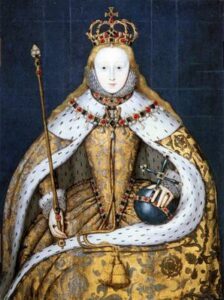
David Starkey writes in his book, “Elizabeth”, of how the well-known portrait of the teenage Elizabeth shows auburn hair, inherited from her father, a “delicate mouth and her long, slightly arched nose” and her mother’s “coal-black eyes”. This portrait also shows her long and slender hands.
Alison Plowden, in “Elizabeth I”, writes of how the Imperial Ambassador in Henry VIII’s reign, Eustace Chapuys, described a five year old Elizabeth as “very pretty”. This was a man who hated Elizabeth’s mother, Anne Boleyn, whom he called “the concubine”, so Elizabeth must have been an attractive child for Chapuys to speak well of her!
According to William Cecil’s son, Thomas, King Philip was “enamoured” with a twenty-something Elizabeth when he was married to her half-sister Mary because Elizabeth was “a fair and beautiful woman”, and in 1557 Giovanni Michiel, the Venetian ambassador, gave an account of the Princess Elizabeth, saying:
“My Lady Elizabeth is a young woman whose mind is considered no less excellent than her person, although her face is comely rather than handsome, but she is tall and well formed, with a good skin, although sallow. She has fine eyes and above all a beautiful hand of which she makes a display; and her intellect and understanding are wonderful, as she showed very plainly by her conduct when in danger and under suspicion. As a linguist she excels the Queen [Mary I], for besides Latin she has no slight knowledge of Greek and speaks Italian more than the Queen does, taking so much pleasure in that from vanity she will never speak any other language with Italians. She is proud and haughty, as although she knows that she was born of such a mother, she nevertheless does not consider herself of inferior degree to the Queen, whom she equals in self-esteem….She prides herself on her father and glorifies in him; everybody saying that she also resembles him more than the Queen does”
What we can gather from all of these descriptions of Elizabeth in her youth, together with the portrait of the Princess Elizabeth, the Whitehall Family portrait and Elizabeth’s coronation portrait, is that Elizabeth had her father’s auburn hair and hooked nose, her mother’s dark eyes and swarthy complexion, and elegant hands with long, slender fingers. Like her mother, she is not described as a classic beauty, but it seems that also like her mother, her wit and intelligence shone through and that she had a certain “je ne sais quoi”! She was certainly never short of admirers, so perhaps she had Anne Boleyn’s famous sex appeal – she definitely had her flirtatious nature!
Elizabeth enhanced her assets with high fashion and jewels. She is said to have had over 3,000 gowns, which were often decorated with jewels, and she had shoes made on a weekly basis. She also loved low cut necklines, red wigs, extravagant costumes and jewellery. She must have cut an imposing figure when she was welcoming foreign ambassadors to her court.
To see what may be a more realistic image of Elizabeth, you can click here to visit a site about Blanche Parry, Elizabeth’s good friend, where there is a photo of a portrait thought to have been painted in the 1580s by Joost de Hondt. This portrait is said to resemble an engraving of Elizabeth I by Crispin van de Passe the Elder and to be a better likeness of the Queen than official portraits. I love this portrait – thanks go to Rochie for telling me about it!
If you have found any descriptions of Elizabeth I in her youth or in her later years, feel free to leave them as comments below.
P.S. Remember to email your Elizabeth I competition entry to [email protected] – I will be judging them over the weekend, along with 2 other judges, and announcing the winner on Monday. Good luck!


